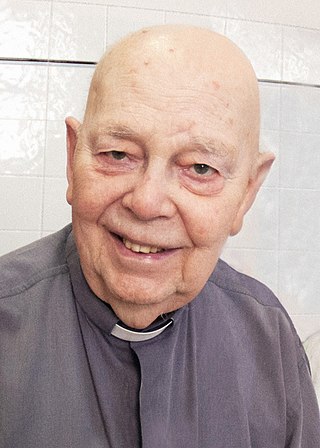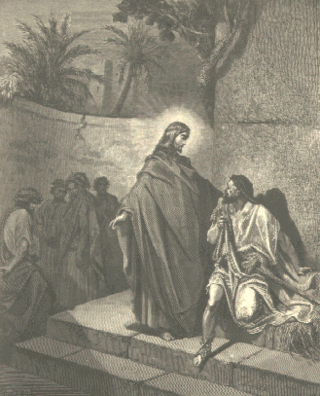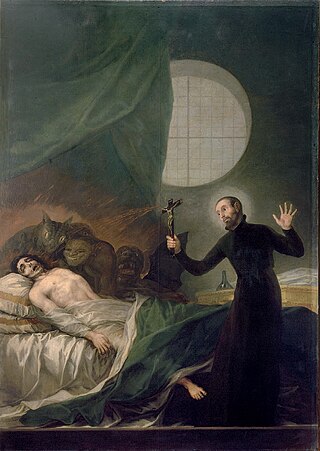
The Exorcist is a 1971 horror novel written by American writer William Peter Blatty and published by Harper & Row. The book details the demonic possession of eleven-year-old Regan MacNeil, the daughter of a famous actress, and the two priests who attempt to exorcise the demon. The novel was the basis of a highly successful film adaptation released two years later, whose screenplay was also written and produced by Blatty. More movies and books were eventually added to The Exorcist franchise.
In some religions, an exorcist is a person who is believed to be able to cast out the devil or performs the ridding of demons or other supernatural beings who are alleged to have possessed a person, or (sometimes) a building or even an object. An exorcist can be a specially prepared or instructed person including: priest, a nun, a monk, a witch doctor (healer), a shaman, a psychic or a geomancer.

Gabriele Amorth was an Italian Catholic priest of the Paulines and an exorcist for the Diocese of Rome. Amorth, along with five other priests, founded the International Association of Exorcists.
James J. LeBar was a Roman Catholic priest who was the chief exorcist of the Archdiocese of New York in the United States.
Walter H. HalloranSJ was a Catholic priest of the Society of Jesus who, at the age of twenty-six, assisted in the exorcism of Roland Doe, a thirteen-year-old Lutheran boy in Cottage City, Maryland, who was allegedly possessed. The case inspired William Peter Blatty to write his novel The Exorcist.

William S. Bowdern was a Catholic priest of the Society of Jesus in St. Louis, Missouri. He was the author of The Problems of Courtship and Marriage printed by Our Sunday Visitor in 1939. He was a graduate of and taught at St. Louis University High School; he also taught at St. Louis University.
Raymond J. Bishop was a Catholic priest who was one of the several involved in the case of exorcising a boy in Maryland, who allegedly was possessed after using a ouija board. The case inspired author William Peter Blatty to write his 1971 novel The Exorcist.

Dominion: Prequel to the Exorcist is a 2005 American supernatural horror film directed by Paul Schrader and written by William Wisher Jr. and Caleb Carr. The film serves as an alternative prequel to The Exorcist (1973) and is the fifth installment in The Exorcist series. It was intended to be the official prequel to The Exorcist before it was retooled into Exorcist: The Beginning (2004), as Morgan Creek Productions executives feared the already completed film would be unsuccessful. The film stars Stellan Skarsgård, Clara Bellar, Gabriel Mann and Billy Crawford.

Possessed is a 2000 American made-for-television horror film directed by Steven E. de Souza, written by de Souza and Michael Lazarou, and starring Timothy Dalton. The film is based on events appearing in the book Possessed by Thomas B. Allen, which was inspired by the exorcism case of Roland Doe.

Exorcism is the religious or spiritual practice of evicting demons, jinns, or other malevolent spiritual entities from a person, or an area, that is believed to be possessed. Depending on the spiritual beliefs of the exorcist, this may be done by causing the entity to swear an oath, performing an elaborate ritual, or simply by commanding it to depart in the name of a higher power. The practice is ancient and part of the belief system of many cultures and religions.
Thomas Benton Allen was an American author and historian. He resided in Bethesda, Maryland. He was also the father of science fiction writer Roger MacBride Allen. Allen was a contributing editor to National Geographic. Allen had co-authored numerous books with Norman Polmar. He had also written numerous mystery novels.
Graham H. Twelftree is an Australian biblical scholar who currently serves as the Academic Dean of London School of Theology in London, UK.

Pazuzu is a fictional character who is the main antagonist in The Exorcist horror novels and film series, created by William Peter Blatty. Blatty derived the character from Assyrian and Babylonian mythology, where the mythic Pazuzu was considered the king of the demons of the wind, and the son of the god Hanbi. In The Exorcist, Pazuzu appears as a demon who possesses Regan MacNeil.
In the late 1940s, in the United States, priests of the Roman Catholic Church performed a series of exorcisms on an anonymous boy, documented under the pseudonym "Roland Doe" or "Robbie Mannheim". The 14-year-old boy was alleged to be a victim of demonic possession, and the events were recorded by the attending priest, Raymond J. Bishop. Subsequent supernatural claims surrounding the events were used as elements in William Peter Blatty's 1971 novel The Exorcist. In December 2021, The Skeptical Inquirer reported the purported true identity of Roland Doe/Robbie Mannheim as Ronald Edwin Hunkeler.

In Christianity, exorcism involves the practice of casting out one or more demons from a person whom they are believed to have possessed. The person performing the exorcism, known as an exorcist, is often a member of the Christian Church, or an individual thought to be graced with special powers or skills. The exorcist may use prayers and religious material, such as set formulas, gestures, symbols, icons, or amulets. The exorcist often invokes God, Jesus, angels and archangels, and various saints to aid with the exorcism. Christian exorcists most commonly cast out demons in Jesus' name.

The Catholic Church authorizes the use of exorcism for those who are believed to be the victims of demonic possession. In Roman Catholicism, exorcism is a sacramental but not a sacrament, unlike baptism or confession. Unlike a sacrament, exorcism's "integrity and efficacy do not depend ... on the rigid use of an unchanging formula or on the ordered sequence of prescribed actions. Its efficacy depends on two elements: authorization from valid and licit Church authorities, and the faith of the exorcist." The Catechism of the Catholic Church states: "When the Church asks publicly and authoritatively in the name of Jesus Christ that a person or object be protected against the power of the Evil One and withdrawn from his dominion, it is called exorcism."

The Exorcist III is a 1990 American psychological horror film written for the screen and directed by William Peter Blatty, based on his 1983 novel Legion. It is the third installment in The Exorcist film series, and the final installment in Blatty's "Trilogy of Faith". The film stars George C. Scott, Ed Flanders, Jason Miller, Scott Wilson, Nicol Williamson, and Brad Dourif.

The Exorcist is an American horror media franchise that originated with William Peter Blatty's 1971 horror novel of the same name and most prominently featured in a 1973 film adaptation of the novel, and many subsequent prequels and sequels. All of these installments focus on fictional accounts of people possessed by Pazuzu, the main antagonist of the series, and the efforts of religious authorities to counter this possession.

Thomas Valentine Bermingham, SJ was an American Jesuit priest, and Classical teacher and scholar. In addition to his academic career at institutions including Fordham University and Georgetown University, he was known for his involvement in the production of the 1973 horror film The Exorcist, on which he worked as a technical advisor as well as acting in a minor role.
Vincent Lampert is an American Catholic priest and the designated exorcist of the Roman Catholic Archdiocese of Indianapolis. Father Lampert was appointed to become an exorcist by Archbishop Daniel M. Buechlien. He is one of the few exorcists known to use social media like Twitter (@FrVinceLampert) on a regular basis. In one article he told the reporter that he is fighting the devil by tweeting about exorcism.











